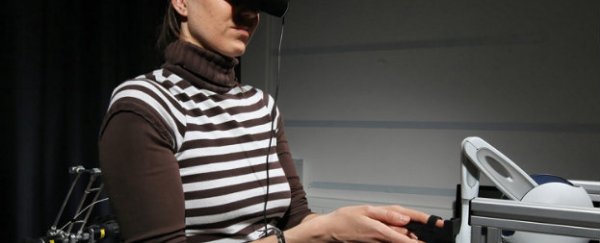"Just because you can't see her, doesn't mean she can't see you. And if you're really quiet, you might just be able to hear her, whispering."
This sounds like a line out of a supernatural film, but for some people, feeling a presence around them is something they must learn to live with. The feeling is particularly common in patients suffering from neurological or psychiatric disorders, who report a presence they can feel but can't see, just like a ghost or a guardian angel.
In an attempt to understand why this is the case, scientists in Switzerland developed an illusion to make healthy people feel a ghostly presence. The results of the simulation were astonishing, revealing that the experience is due to mismatched sensory and motor information that confuses the brain.
The team from the École Polytechnique Fédérale de Lausanne designed a set-up involving two robots - one that sits in front of the participant, and one that sits behind them. Each participant was asked to put their finger into a hole in the front robot, and move their hand around. Information about this movement was transmitted to the robot sitting behind, which prompted it to put its hand on the participant's back, mimicking their movements in real-time. This made the participant feel like they were touching their own back, but because the robot was so in-sync with their movements, their brain was able to adapt to the feeling.
Next, the team added a short delay between the participant's hand movements and the robot's touch - and this is where things got interesting. After three minutes of delayed touching, several participants felt that there was someone behind them, and others counted up to four 'ghosts' in the room. Even though the robot was standing behind them, the volunteers were aware of its presence, and still reported the distinct feeling.
"For some, the feeling was even so strong that they asked to stop the experiment," said Giulio Rognini, robotic scientist and one of the team, in a press release.
The results suggest that when the robot's touch was out-of-sync with the participant's hands movements, the brain couldn't identify the signals as belonging to the participant's body, but rather as someone else.
"Our experiment induced the sensation of a foreign presence in the laboratory for the first time. It shows that it can arise under normal conditions, simply through conflicting sensory-motor signals," said Olaf Blanke, neuroscientist and one of the team, in a press release. "The robotic system mimics the sensations of some patients with mental disorders or of healthy individuals under extreme circumstances. This confirms that it is caused by an altered perception of their own bodies in the brain."
As part of the study, the team used MRI scans to analyse the brains of 12 patients with neurological disorders - mostly epilepsy - who had felt a presence as a result of their condition. They were able to trace the feeling to damage in three regions in their brains: the insular cortex, parietal-frontal cortex, and the temporo-parietal cortex. These three areas are involved in self awareness, movement, and a sense of position within one's environment. And most importantly, they work together to influence how a person perceives their own body.
The findings could help scientists to better understand the hallucinations that are experienced by schizophrenic patients, and could one day open up a way to control such delusions. The team now wants to analyse the participants' brains to see what regions are affected when they experience the illusion.
This study may be comforting to those of you who have had such an experience, and if it happens again, remember - it's just your mind playing tricks with you.
The findings are published in the journal Current Biology.
Watch this video to find out how the 'ghost robot' works:
Source: EurekAlert
